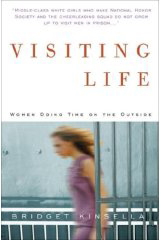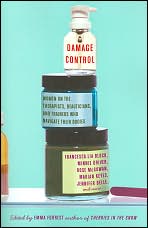When Bridget Kinsella begins a correspondence with
Pelican Bay inmate Rory Mehan, she never expects that their relationship
will go beyond the professional; she was a literary agent, he was a
writer. But as the months (and letters) pass, Bridget begins to think
of Rory in more intimate terms than a colleague, and he her. Which gets
her thinking: Bridget Kinsella's Visiting Life: Women Doing Time on the Outside is a unique blend of reporting and memoir. Bridget's own story-- an early divorce, the prospect of turning 40, the realization that her long-held dream of motherhood wasn't likely to come true-- is inter-cut with the profiles and interviews of several women whose husbands and boyfriends are inmates at Pelican Bay. Kinsella's approach with her fellow visiting women
is always gentle and nonjudgmental. She shares their stories with respect,
reflecting their intelligence, strength, and resilience, and noting
with care issues faced by couples and families challenged by imprisonment.
Each woman gets a chapter to herself, in which she shares how she met
her partner, how much she knows about her partner's crimes, and the
reactions of her family and friends to her relationship with an inmate.
The women Kinsella profiles come from varied backgrounds and life experiences.
Taken together with Kinsella's own experiences, it's clear that while
every woman who decides to share her life with a prison inmate is different,
their stories are similar-- the financial difficulties, the loneliness,
the concern about family and friends' Brutally honest about the emotional trauma that has haunted her for years, Kinsella's raw exposure of her vulnerabilities is searing. Her emotional reliance on Rory and his willingness to be the salve that lets her finally heal is validated by the rewarding yet poignant conclusion to her book. Excerpts of Rory's letters illustrate the depth of his feelings for Kinsella and his desire and willingness to help her move forward emotionally. It's hard not to be skeptical about Rory's motives; as Kinsella herself acknowledges, he could be a master at manipulation. But their consistent and long-term connection affirms the genuineness of their relationship. The book occasionally wanders into excessive navel-gazing on Kinsella's part, but the emotional growth and personal revelations she experiences far outweigh any weakness in the narrative. Her warm and intimate writing style carries the reader along; while aspects of Kinsella's story have caused her profound sorrow, her story is never sad. The ultimate resolution of her and Rory's relationship, as well as the decisions she makes in moving forward with her life, overcoming the obstacles to her happiness in ways she never imagined, eliminates any skepticism on the part of the reader that Rory's too good to be true or that Kinsella isn't fully aware of what she's gotten herself into.
by Emma Forrest Avon,
2007 I've always had a love/hate relationship with getting my hair cut. On the one hand, I love the idea of reinvention, like if I look great, then everything else in my life will magically fall into place. On the other hand, I get extremely anxious about trusting someone else with how I look, the image I show the world. Really, it all goes back to an awful haircut in the '80s. I ended up with one of those have-it-both ways cuts, where one side was super-short and skimmed my ear while the other, longer, layered side was big and blown out; I cried for hours and ended up back at the salon to get it fixed. "Why didn't you just say you didn't want this?" the hairdresser asked. Um, I was 12. I didn't know I could say no. With equally personal anecdotes and self-analysis, the almost two dozen women who have contributed to Damage Control: Women on the Therapists, Beauticians, and Trainers Who Navigate Their Bodies, edited by Emma Forrest, reveal their own love/hate relationships with hairdressers, manicurists, massage therapist, personal trainers, tattoo artists, and more. The book also includes brief interviews with these same beauty professionals, revealing that the complexity of these encounters often cuts both ways. Writers, actresses, and journalists, including Minnie
Driver, Rose McGowan, Jennifer Belle, and Francesca Lia Block talk honestly
about their insecurities and their vulnerabilities, the trust (sometimes
misplaced) that they've placed in the beauty and aesthetic professionals
they've turned to, and the effects-- some long-reaching-- of these encounters.
Marian Keyes fights the urge to blow up when she's kept waiting at her
appointment for a blow out. The tone and focus of the essays compiled by editor
Emma Forrest (author of Namedropper, Cherries in the Snow) is wide-ranging,
reflecting a diversity of age, experience, culture, economics, and more.
The deeply personal revelations of the writers are surprising, and at
first blush, almost too intimate to be sharing with a total stranger
like me, an ordinary reader. But that's the unexpected appeal of Damage
Control. The value placed on beauty, however it's defined across cultures,
does have an effect on women, as do the steps we take and the people
we turn to for help to achieve it. Whether they're reeling from bad
breakups or serious health problems, resolving family secrets or personal
demons, each of the contributors to Damage Control shares commentary,
analysis, and camaraderie that is relatable to all readers. Who can't
remember the sudden realization that the "perfect" While at times the anthology does feel slightly too
broad in scope, I think it's more a testament to the numerous ways in
which women have the opportunity to manipulate their bodies-- massages
and personal training sessions, manicures and blow outs, reflexology
and acupuncture, cosmetics and plastic surgery, thereby providing an
overarching cohesiveness to the book, despite the differences between
the individual essays. Amy Brozio-Andrews (http://www.amyba.com)
is a freelance writer and book reviewer. |




 Visiting
Life
Visiting
Life Damage
Control
Damage
Control



